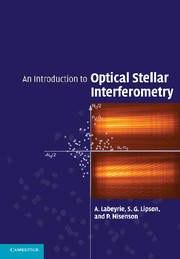Book contents
- Frontmatter
- Contents
- List of Illustrations
- Preface
- Peter Nisenson, 1941–2004
- 1 Introduction
- 2 Basic concepts: a qualitative introduction
- 3 Interference, diffraction and coherence
- 4 Aperture synthesis
- 5 Optical effects of the atmosphere
- 6 Single-aperture techniques
- 7 Intensity interferometry
- 8 Amplitude interferometry: techniques and instruments
- 9 The hypertelescope
- 10 Nulling and coronagraphy
- 11 A sampling of interferometric science
- 12 Future ground and space projects
- Appendix A
- Appendix B
- Index
9 - The hypertelescope
Published online by Cambridge University Press: 23 February 2010
- Frontmatter
- Contents
- List of Illustrations
- Preface
- Peter Nisenson, 1941–2004
- 1 Introduction
- 2 Basic concepts: a qualitative introduction
- 3 Interference, diffraction and coherence
- 4 Aperture synthesis
- 5 Optical effects of the atmosphere
- 6 Single-aperture techniques
- 7 Intensity interferometry
- 8 Amplitude interferometry: techniques and instruments
- 9 The hypertelescope
- 10 Nulling and coronagraphy
- 11 A sampling of interferometric science
- 12 Future ground and space projects
- Appendix A
- Appendix B
- Index
Summary
Imaging with very high resolution using multimirror telescopes
Recent years have seen very large aperture telescopes constructed by piecing together smaller mirrors and carefully mounting them on a frame so that the individual images interfere constructively at the focus. This way the two multimirror Keck telescopes on Mauna Kea are constructed, each from 36 hexagonally shaped mirrors which together form a paraboloidal mirror about 10 m in diameter. The frame is constructed very rigidly, but since each segment weighs half a ton, it still distorts significantly when the telescope is pointed, so that the mirror positions have to be actively corrected to compensate for the small movements. Then, together with adaptive optics correction for atmospheric turbulence, diffraction-limited images are obtained since, for a small enough field of view, the off-axis aberrations of the paraboloidal mirror are insignificant. However, the maximum aperture which can be operated this way is expected to be of the order of 100 m, the size of the “Overwhelmingly Large Array” (OWL) being studied by the European Southern Observatories. The resolution achievable for a pointable direct imaging telescope is therefore limited to a few milli-arcseconds at optical wavelengths.
By using synthetic imaging, interferometry represents one way around this problem, when angular resolution rather than light-gathering power is the dominant aim. Effective apertures of hundreds of meters have been achieved, but the number of subapertures is still quite modest. As we have seen in the preceding chapters, interferometers with even tens of apertures and optical delay lines become extremely expensive and complicated to operate.
- Type
- Chapter
- Information
- An Introduction to Optical Stellar Interferometry , pp. 212 - 231Publisher: Cambridge University PressPrint publication year: 2006

